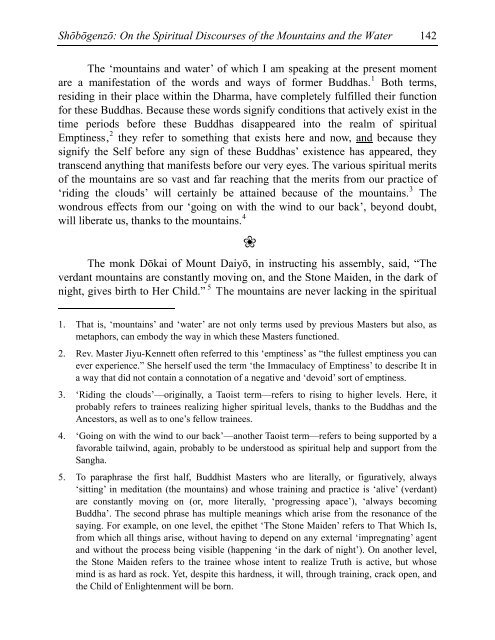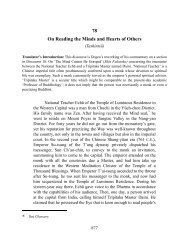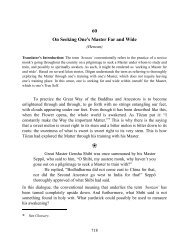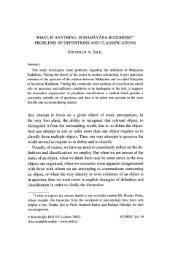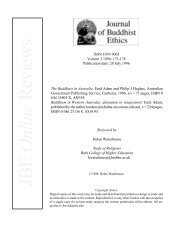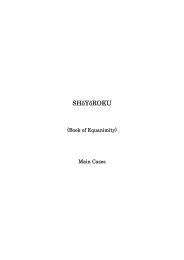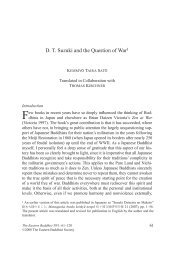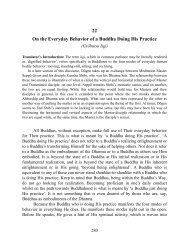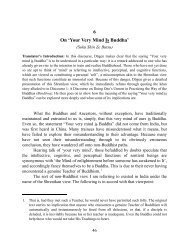Sansui Kyo - thezensite
Sansui Kyo - thezensite
Sansui Kyo - thezensite
- No tags were found...
Create successful ePaper yourself
Turn your PDF publications into a flip-book with our unique Google optimized e-Paper software.
Shōbōgenzō: On the Spiritual Discourses of the Mountains and the Water 142The ‘mountains and water’ of which I am speaking at the present momentare a manifestation of the words and ways of former Buddhas. 1 Both terms,residing in their place within the Dharma, have completely fulfilled their functionfor these Buddhas. Because these words signify conditions that actively exist in thetime periods before these Buddhas disappeared into the realm of spiritualEmptiness, 2 they refer to something that exists here and now, and because theysignify the Self before any sign of these Buddhas’ existence has appeared, theytranscend anything that manifests before our very eyes. The various spiritual meritsof the mountains are so vast and far reaching that the merits from our practice of‘riding the clouds’ will certainly be attained because of the mountains. 3 Thewondrous effects from our ‘going on with the wind to our back’, beyond doubt,will liberate us, thanks to the mountains. 4 ❀The monk Dōkai of Mount Daiyō, in instructing his assembly, said, “Theverdant mountains are constantly moving on, and the Stone Maiden, in the dark ofnight, gives birth to Her Child.” 5 The mountains are never lacking in the spiritual1. That is, ‘mountains’ and ‘water’ are not only terms used by previous Masters but also, asmetaphors, can embody the way in which these Masters functioned.2. Rev. Master Jiyu-Kennett often referred to this ‘emptiness’ as “the fullest emptiness you canever experience.” She herself used the term ‘the Immaculacy of Emptiness’ to describe It ina way that did not contain a connotation of a negative and ‘devoid’ sort of emptiness.3. ‘Riding the clouds’—originally, a Taoist term—refers to rising to higher levels. Here, itprobably refers to trainees realizing higher spiritual levels, thanks to the Buddhas and theAncestors, as well as to one’s fellow trainees.4. ‘Going on with the wind to our back’—another Taoist term—refers to being supported by afavorable tailwind, again, probably to be understood as spiritual help and support from theSangha.5. To paraphrase the first half, Buddhist Masters who are literally, or figuratively, always‘sitting’ in meditation (the mountains) and whose training and practice is ‘alive’ (verdant)are constantly moving on (or, more literally, ‘progressing apace’), ‘always becomingBuddha’. The second phrase has multiple meanings which arise from the resonance of thesaying. For example, on one level, the epithet ‘The Stone Maiden’ refers to That Which Is,from which all things arise, without having to depend on any external ‘impregnating’ agentand without the process being visible (happening ‘in the dark of night’). On another level,the Stone Maiden refers to the trainee whose intent to realize Truth is active, but whosemind is as hard as rock. Yet, despite this hardness, it will, through training, crack open, andthe Child of Enlightenment will be born.


